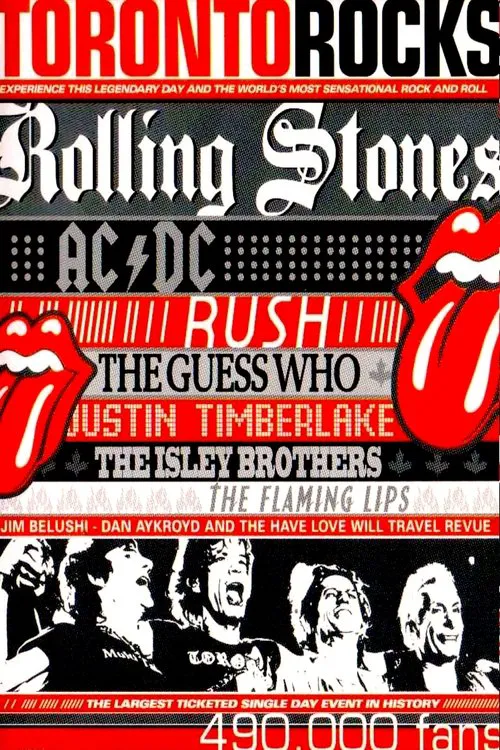Toronto Rocks

Plot
In July of 2003, the city of Toronto was facing a major public health crisis in the form of a SARS outbreak, resulting in widespread fear and economic hardship. To help alleviate this situation, organizers planned a massive benefit concert, dubbed "Molson Canadian Rocks for Toronto" or "Toronto Rocks" for short. This star-studded event was designed to raise funds and promote unity and solidarity in the face of adversity. Taking place on July 30, 2003, at Downsview Park, a sprawling outdoor venue on the outskirts of the city, the concert brought together an incredible assembly of musical talent. The event was headlined by the legendary rock band, The Rolling Stones, who had previously performed in the city a mere eight months prior. However, as the SARS crisis deepened, the city's public health officials and concert organizers made the joint decision to move this highly anticipated performance to a larger outdoor setting. To make up for the loss, organizers decided to put on an even bigger concert than initially planned. The lineup expanded to include some of the world's most prominent rock bands of the time, such as The Cure, AC/DC, The Killers, Sum 41, The Doves, Our Lady Peace, and many more. This extensive bill of acts was designed to entice a massive crowd and showcase the diversity and resilience of Toronto's music scene. As the day of the concert approached, excitement and anticipation grew among the city's residents. The event's estimated attendance of between 450,000 to 500,000 people more than doubled the venue's capacity and solidified its status as the largest outdoor ticketed event in Canadian history. It also made "Toronto Rocks" one of the largest in North American history, further cementing its place in the record books. The SARS crisis had already caused widespread economic disruption in Toronto, with many businesses forced to close their doors due to the virus. The concert's organizers aimed to not only showcase the city's thriving music scene but also provide a much-needed economic boost. Ticket sales from the event and merchandise generated a significant amount of revenue, which was then donated to the Toronto Board of Trade's Toronto's Response Fund to support those afflicted by the SARS outbreak. As the concert commenced, a sea of enthusiastic spectators descended upon Downsview Park. Despite the early morning traffic and logistical challenges, attendees were eager to soak in the musical energy. Over the course of several hours, fans were treated to an incredible display of musical prowess, with acts taking to the stage under the scorching summer sun. The Rolling Stones took the stage towards the end of the day, delivering a commanding performance of their most well-known hits. The Cure and AC/DC also received standing ovations, each delivering high-energy sets that left the audience awestruck. Other notable performances included those by Sum 41, The Doves, and Our Lady Peace, who showcased their respective styles and left fans begging for more. As the final chords of the last performance faded away, the massive crowd began to disperse. While many attendees took to social media and local news outlets to share their photos and recount their experiences, organizers reported over $3 million raised for the Toronto Board of Trade's relief fund. This substantial donation helped alleviate some of the financial burdens placed on the city by the SARS outbreak, as well as demonstrating the city's resilience and generosity in the face of adversity. Ultimately, the "Toronto Rocks" concert served as a testament to the city's capacity for unity and solidarity in the face of adversity. By bringing together thousands of music lovers, it highlighted the power of the arts to heal and bring people together. As the years have passed, "Toronto Rocks" has been etched into the collective memory of the city and the rock music landscape, a momentous occasion that brought an entire community together in a celebration of music and determination.
Reviews
Recommendations



